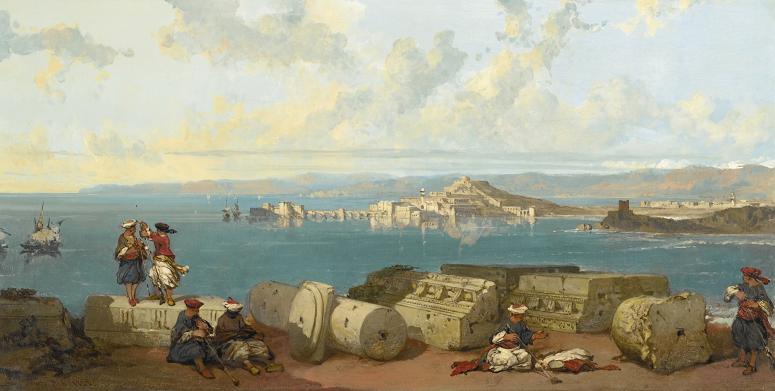Sidon. Sidon, known locally as Sayda or Saida, is the third-largest city in Lebanon. It is located in the South Governorate, of which it is the capital, on the Mediterranean coast. Tyre to the south and Lebanese capital Beirut to the north are both about 40 kilometres away. Sidon has a population of about 80,000 within city limits, while its metropolitan area has more than a quarter-million inhabitants. This was hellenized as Sidṓn, which was Latinized as Sidon. As a Roman colony, it was notionally refounded and given the formal name Colonia Aurelia Pia Sidon to honor its imperial sponsor. In the Book of Genesis, Sidon was the first-born son of Canaan, who was a son of Ham, thereby making Sidon a great-grandson of Noah. Sidon has been inhabited since very early in prehistory. The archaeological site of Sidon II shows a lithic assemblage dating to the Acheulean, whilst finds at Sidon III include a Heavy Neolithic assemblage suggested to date just prior to the invention of pottery. It was one of the most important Phoenician cities, and it may have been the oldest. From there and other ports a great Mediterranean commercial empire was founded. Homer praised the skill of its craftsmen in producing glass, purple dyes, and its women's skill at the art of embroidery. It was also from here that a colonizing party went to found the city of Tyre. Tyre also grew into a great city, and in subsequent years there was competition between the two, each claiming to be the metropolis of Phoenicia. Glass manufacturing, Sidon's most important enterprise in the Phoenician era, was conducted on a vast scale, and the production of purple dye was almost as important. The small shell of the Murex trunculus was broken in order to extract the pigment that was so rare it became the mark of royalty. In AD 1855, the sarcophagus of King Eshmun'azar II was discovered. From a Phoenician inscription on its lid, it appears that he was a king of the Sidonians, probably in the 5th century BC, and that his mother was a priestess of Ashtart, the goddess of the Sidonians.In this inscription the gods Eshmun and Baal Sidon 'Lord of Sidon' are mentioned as chief gods of the Sidonians. Ashtart is entitled Ashtart-Shem-Baal 'Ashtart the name of the Lord', a title also found in an Ugaritic text. In the years before Christianity, Sidon had many conquerors: Assyrians, Babylonians, Egyptians, Persians, Greeks, and finally Romans. Herod the Great visited Sidon. Both Jesus and Saint Paul are said to have visited it, too. The city was eventually conquered by the Arabs and then by the Ottoman Turks. Like other Phoenician city-states, Sidon suffered from a succession of conquerors. At the end of the Persian era in 351 BC, it was invaded by the emperor Artaxerxes III and then by Alexander the Great in 333 BC, when the Hellenistic era of Sidon began. Under the successors of Alexander, it enjoyed relative autonomy and organized games and competitions in which the greatest athletes of the region participated. In the Necropolis of Sidon, important finds such as the Alexander Sarcophagus, the Lycian tomb and the Sarcophagus of the Crying Women were discovered, which are now on display at the Archaeological Museum of Istanbul. When Sidon fell under Roman domination, it continued to mint its own silver coins. The Romans also built a theater and other major monuments in the city. In the reign of Elagabalus, a Roman colony was established there. During the Byzantine period, when the great earthquake of AD 551 destroyed most of the cities of Phoenice, Beirut's School of Law took refuge in Sidon. The town continued quietly for the next century, until it was conquered by the Arabs in AD 636. On 4 December 1110 Sidon was captured, a decade after the First Crusade, by King Baldwin I of Jerusalem and King Sigurd I of Norway. It then became the centre of the Lordship of Sidon, an important lordship in the Kingdom of Jerusalem. Saladin captured it from the Crusaders in 1187, but German Crusaders restored it to Christian control in the Crusade of 1197. It would remain an important Crusader stronghold until it was finally destroyed by the Saracens in 1249. In 1260 it was again destroyed by the Mongols. The remains of the original walls are still visible.
more...



